Smith Island is the quickly vanishing home of one the last living remnants of colonial U.S. history.
Anywhere else in the United States—or, really, the world— I would have thought twice about the offer I had just received: a stranger in the middle of nowhere, driving an old maroon Buick with no license plates, had just offered me a ride. But on Smith Island, on Maryland’s Eastern Shore, time stands still; here, it didn’t seem quite so intimidating.
“Y’gwon t’yule?” the stranger asked, leaning out of his car.
“Sorry?” I replied.
He tried again. “I said, ‘Y’gwon t’yule?’ ”
After half a tick, it dawned on me that he wanted to know if I was “going to Ewell.” I said I was, and he asked if I wanted to join him. I weighed my options and gazed down the two-mile stretch of asphalt ahead of me, rippling in the afternoon heat. I looked at my Sunday best, nearly soaked through with sweat, and got in the car.
My Smith Island savior was 76-year-old Junior Evans. He has lived on Smith Island his entire life, a member of one of the many, many Evans families on the island. Most of the same families that landed on Smith Island when the first settlers came up the Chesapeake Bay during the mid-1600s still exist there today. The cemetery in the largest town, Ewell—pronounced “yule” by locals—is mostly populated by Evans’ and Tylers, giving the town’s graveyard the appearance of one giant family plot. Despite sitting less than 100 miles as the crow flies from the nation’s capitol, Smith Island and its dwindling population of less than 200 can only be accessed by a boat, a long drive, and a strong sense of adventure. Though I had grown up outside of Annapolis, an area with many actively working watermen, most of my experience on the Chesapeake Bay was driving over it. Just like any Marylander, I was also skilled with a crab knife and mallet, tearing apart messy steamed crabs on a makeshift newspaper tablecloth. But despite being near the Bay for almost my entire life, I had no concept of the lives of watermen. And I had no idea Smith Island existed.

I climbed into Evans’ unlicensed car (most of the cars on Smith Island have no license plates, no registration, and no insurance), and after a moment of standard pleasantries I asked him if he was retired. He looked confused, then angry, but politely grumbled, “Watermen don’t retire.” A waterman is a distinct term used by those who work the Chesapeake Bay. Originally used by the British to describe smugglers, it was later used as a term for riverboat workers that transported passengers on small skiffs. When the British colonized the Chesapeake Bay region, the name stuck.
Today, watermen make their living from the Bay: crabbing in the summer and harvesting oysters and fishing in the winter. It’s a hard life, but watermen usually work for no man but themselves. Evans was the first person to use a fiberglass, as opposed to wooden, boat on the Chesapeake Bay; the same boat that he would use the next morning after waking up “late” at 4 a.m. to work the water, as he has done his entire life.
We drove along the long expanse of road from Rhodes Point across the marshy interior of Smith Island to Ewell, passing an abandoned car along the way. Ever since the first Evans’ and Tylers settled on the island, Smith Islanders’ language has remained an oddity. Linguists say that their accent still resembles the Elizabethan style of speech their ancestors used, and to outsiders it probably resembles the similarly unusual Outer Banks Brogue. However, to the trained ear, it’s entirely different. Most obviously, they have their own vocabulary: Smith Islanders don’t say a storm is approaching, they say “there’s a rim coming”; they don’t bake cakes from scratch, they bake them “from stump”; if the water is completely still, it’s “slick cam.”

On my first day in Smith Island, I went to meet up with Pastor Rick, the leader of the local Methodist ministry. Without any local government (or police presence, or doctors), the Methodist Church has traditionally been the center of local governance. This is why Smith Island is as dry as a bone. Technically, Smith Island is considered an unincorporated community of Somerset County, but servicing agencies can vary from State Police to county officials to the Department of Natural Resources. After waiting for almost twenty minutes past our roughly prearranged time, he was nowhere to be seen. I asked a local if they had seen him; they hadn’t. After poking around the nearby general store for five minutes and coming up empty, I returned to the stoop by the pastor’s residence.
A minute later, a woman I had never seen before came by and asked if I had found the pastor. Ten minutes passed, and another completely unfamiliar woman walked by and asked if I’d had any luck. In less than twenty minutes, word had gotten around to almost the entire town that there was an “outsider” (my term, not theirs) looking for the pastor. It was all hands on deck. Even after finding the pastor later that afternoon, at lunch the next day, I had an unfamiliar waitress ask me if I’d ever tracked him down. I had gone viral on Smith Island.
As I continued to wait for the pastor, a young, barefoot boy in jean shorts named Nathan buzzed around me like the many greenhead flies on Smith Island. His line of questioning was thorough.
“Are you one of the Jetty workers?” he asked, referring to a badly needed protective jetty currently under construction by the Army Corps of Engineers to protect Smith Island from storms and erosion, which according to the Army Corps has claimed roughly 1,200 acres of their land in the last century.
“Are you one of the Verizon workers?” Nathan tried again, in reference to the single Verizon tower that provides patchy cell service and Internet to the area. Finally, Nathan decided that I looked like his favorite British Minecraft vlogger.
Nathan is one of less than ten students that attend Ewell School, the kindergarten through seventh-grade school that serves the three towns of Smith Island. Once students graduate to eighth grade, they must take a daily 30-40 minute ferry to the nearest mainland town of Crisfield for high school. Aside from the much-discussed issue of erosion, rising sea levels and the threat of storms, the island’s lack of young people is nearly as dire. On Smith Island, the median age of residents is 58, compared to 39 in Crisfield. Only 30 residents on the island are under the age of 21.

Later, I rode along with Pastor Rick as he did his church service rounds. He holds a 9 a.m. service for the congregation at Ewell, then “rushes” (though no one really rushes on Smith Island) onto an open 20-foot skiff piloted by an inscrutable waterman named Ronnie. The boat takes him across a small channel to service in Tylerton at 10:45.
If Ewell is Smith Island’s Big City, then Tylerton is its sleepy cousin. During church time on Sunday in Tylerton, there is not a soul to be seen; the main dock is left unmanned, and the harbor office’s doors swing open as a radio pipes out Christian music to no one but the crabs. Add in the various knives and tools hanging on the wall inside, and the scene looks like a damn good opening sequence to a zombie video game.
Though Smith Island is quiet, it’s still an enticing tourist destination, and this is likely Smith Island’s future. Between the aging population, the tightening of fishing restrictions and the rarity of new waterman licenses, Smith Island needs a new influx of dollars if it intends to survive. Sure, there is the newly constructed Smith Island Museum, which provides a comprehensive history of the island, and there are various boat tours, but if you’re going to Smith Island, you’re probably looking for quiet, untethered adventure. If not, you might be in the wrong place. As a self-proclaimed untethered adventurer myself, I found the shallow-water kayaking around Smith Island to be the best way to enjoy the area.
Seasoned kayakers can paddle through the “guts” of the island that weave through the island’s interior. It’s a kayaker’s heaven as long as you bring copious amounts of bug spray. However, a less experienced paddler could head less than a mile northeast of Ewell to the uninhabited Swan Island. Swan Island is part of the Martin National Wildlife Refuge, a place where herons and osprey fly overhead. More importantly, Swan Island is home to a beautiful, 800-foot-long white sugar-sand beach and shallow sandbar point. It’s here, on Sunday evenings, where locals can be found relaxing at the end of a long week’s work on the water. Though there’s no alcohol sold anywhere on the island, if any were to be found, it would be found on Swan Island on a Sunday.
And yes, there’s the food: the Smith Island Cake, eight to fifteen super-thin layers of fudge alternating with yellow cake. Local folklore says that the many layers of fudge made the cake more durable when packed in watermen’s lunch pails. It’s also the Maryland State dessert, a designation that puts it in the same esoteric league as the state’s official sport, jousting.

As a community that literally runs on seafood, it’s no surprise Smith Islanders know how to cook it. The famous Chesapeake Bay soft shell crabs at “the big restaurant”—the local name for the Bayside Inn Restaurant—are caught by a local waterman in the surrounding waters, housed at a shanty within view of the restaurant itself and picked and cooked in the kitchen by the waterman’s wife.
Unfortunately, Smith Island isn’t indestructible, and it’s not clear that it will survive to reap the benefits of a nascent tourism industry. The island’s biggest problem is the march of time itself. Externally, the island is facing erosion—as much as eight to twelve feet per year—and the ever-present possibility of devastating hurricane damage. On one front, Smith Island has some help: the Army Corps of Engineers is working on completing a $20 million project that will protect over 200 acres of wetlands on the island. Internally, the aging population, combined with a lack of jobs for young people, is causing a rapid decline in residents. Once they graduate from high school, most young Smith Islanders prefer to live on the mainland as watermen licenses are becoming more expensive, harder to come by and offer very little job security or any benefits. The wait list for new waterman licenses is crushing, and existing crabbing licenses are sold in classifieds anywhere between $5,000-$15,000 without any mention of declining crab and oyster harvests in the Bay. At this point, over half of the homes on Smith Island are now owned by “part-timers,” which is just a polite island term for vacationers.

But for now, Smith Island remains. It’s a place that can feel either sleepy or post-apocalyptic, depending on the day of the week. Smith Island is isolated. Smith Island is shrinking. But it’s also a place that has remained almost completely in the lee of time. While we flock to Philadelphia or Williamsburg, Virginia to somehow feel the echo of American history in the buildings and the tours, it’s unlikely that we’ll meet people whose families are a part of that history; people who still live it out on the water and still speak with the same accent and sayings that their great-great-great-great-great grandparents did.
The island’s value as an American time capsule cannot be overstated: Smith Island is America before America even existed. Their sense of independence, individuality, and self-reliance still stand as a gauge of our own. For the true untethered American adventurer, the historical, physical, and psychological isolation of Smith Island is Mecca. Make the pilgrimage while you can.